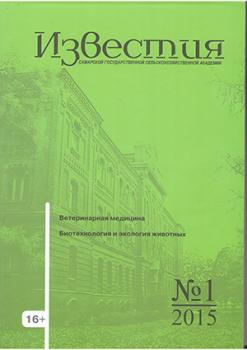Rostov-on-Don, Russian Federation
Rostov-on-Don, Russian Federation
Rostov-on-Don, Russian Federation
The aim of the research is justification of causal relationship patterns of Salmonella and Eimeria, and their role in the pathology of the disease. The authors analyzed the incidence of salmonellosis nutria and eimeriosis depending on the way of the content. 82 the corpses of nutria was conducted post-mortem autopsy and bacteriological examination. For bacteriological examination were selected the heart, lungs, liver with gallbladder, spleen, kidney, brain, mesenteric lymph nodes, bone from fresh corpses. It is established that in conditions of the same economy under the cellular content of the disease were not recorded, and if outdoor, how and when the content of the deep litter, and on the concrete floor had equally widespread. In the study of pathologic material derived from carcasses of dead nutria, have the following distribution of serovars: S. dublin – 22.8%, S. typhimurium – 40.3%, S. choleraesuis – is 36.9%. For bacteriological tests crops held at IBA, with marked diffuse haze. On Endo agar grew transparent slightly bluish or pinkish colonies 2-4 mm in diameter, on the environment Ploskirev – turbid, more dense, Levin – transparent with slight purple tint on the Wilson-Blair – black with a metallic luster. The culture obtained were studied by optical microscopy, detecting single spaced, do not form spores and capsules with a length of 1-4 µm, with a diameter of 0.5-0.8 μm, sticks. For associative flow of Salmonella and Eimeria nutria characteristic of chronic catarrhal gastritis, acute catarrhal-gemorragicescom-necrotic enterocolitis, congestive redness of the serous membranes of the small and large intestine, mesentery, granular and adipose dystrophy of liver, granular dystrophy of kidneys, myocardium, gemorragicescom-necrotic splenic, acute serous lymphadenitis, congestive hyperemia and edema of the lungs, brain and other organs, hemorrhagic diathesis.
nutria, bacteriological, examination, pathological, changes, salmonellosis, eimeriosis
1. Gayvoronskj, V. I. Nematodes of the digestive tract in animals // Actual problems of methodical approaches to the treatment and prevention of animal diseases. - Persianovskj, 2015. - P. 106-110.
2. Kosse, V. F. Pathomorphologic changes in the organs and tissues of hens at Association for infectious and parasitic diseases / V. F. Cosse, O. N. Polosok // Vestnik of Don SAU. - 2014. - № 3. - P. 5-8.
3. Mironova, L. P. Pathological changes in internal organs of nutria in the Salmonella / L. P. Mironova, V. F. Cosse, A. A. Mironov // Bulletin of veterinary medicine. - Stavropol, 2001. - №1. - P. 41-42.
4. Ostrovskj, A. N. Features of the associative diversity of parasites of animals of the Rostov region / A. N. Ostrovsky, S. S. Sable // Issues and trends of innovative development of agroindustrial complex and agricultural education in Russia. - Persianovskj, 2012. - P. 213-215.
5. Ostrovsky, A. N. Diagnosis of subclinical course of mixed helminthiases in animals with the use of the device «Helmi»/ A. N. Ostrovsky, S. A. Kuzyakin // Actual problems of methodical approaches to the treatment and prevention of animal diseases. - Persianovsky, 2015. - P. 120-23.
6. Firsov, D. G. Problems and tendencies of innovative development of agroindustrial complex and agricultural education in Russia / G. D. Firsova, N. Firsov. F. // Mat. International sci.-pract. conf. - Persianovskj, 2012. - P. 185-187.
7. Streptokokken-, Staphylokokken-, Aeromonas- und Aktinobazillus-Jnektionen // Veter. Med. - 1988. - Vol. 42, №6. - P. 877-889.
8. Wendland, B. Untersuchungenuber das Vorkommen bakteriellerin fektons krankheitenbeim Sumpfbiber (Myocastor coypus Molino, 1782) Mitt. 1. Salmonella infection / B. Wendland, B. Kohler, H. Kuhn // Arch exper. Veter. Med. - 1987. - Vol. 41, №3. - P. 420-433.





